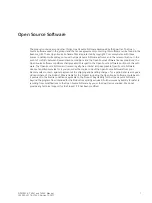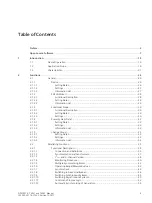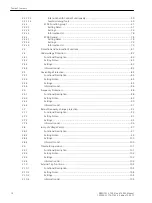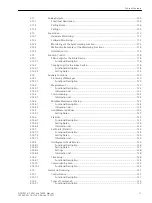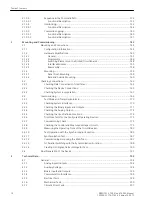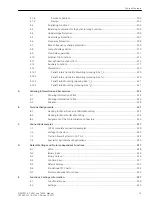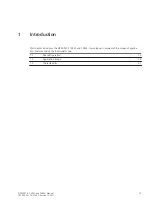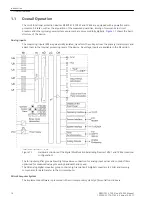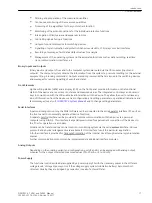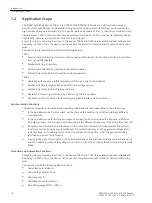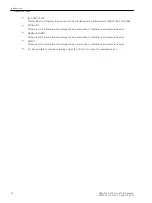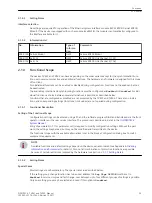
Characteristics
General Characteristics
•
Powerful 32-bit microprocessor system.
•
Complete digital measured value processing and control, from sampling and digitalizing of measured
values up to the switchon and switchoff decisions for power breakers and other switchgear.
•
Total electrical separation between the internal processing stages of the device and the external trans-
former, control and DC supply circuits of the system because of the design of the binary inputs, outputs,
and the DC converters.
•
Easy device operation via an integrated operator panel or by means of a connected personal computer
with the DIGSI operating program.
•
Continuous computation and display of measured quantities.
•
Storage of fault messages and instantaneous or rms values for fault recording.
•
Continuous monitoring of measured values as well as of the hardware and software of the device.
•
Communication with central control and memory storage equipment via serial interfaces, optionally via
data cable, modem, or optic fibre lines.
•
Battery-buffered real time clock that can be synchronized with an IRIG-B (or DCF77) signal, binary input
signal, or system interface command.
•
Statistics: Starting and trip commands from the device are counted.
•
Commissioning aids such as connection check, field rotation check, status display of all binary inputs and
outputs, and test measurement recording.
Synchrocheck, Dead Line/Bus
•
Settable minimum and maximum voltage
•
Verification of the synchronous conditions or the de-energized state is also possible before the manual
closing of the circuit breaker, with separate limit values
•
Fast measuring of voltage difference U
diff
, of the phase angle difference α
diff
and frequency difference f
diff
•
Measurement via transformer (integrated vector group adaptation)
•
Measuring voltages optionally for phase-phase or phase-earth.
Controlling Synchronous Networks
•
Fast measuring of the voltage difference U
diff
and of the phase angle difference α
diff
•
The operating mode is automatically activated (pre-settings), if the frequency difference is f
diff
≈ 0
•
Measurement via transformer (integrated vector group adaptation)
•
Measuring voltages optionally for phase-phase or phase-earth.
Controlling Asynchronous Networks
•
Fast measuring of the voltage difference U
diff
and of the frequency difference f
diff
;
•
Consideration of the angle difference with prediction of the point of synchronism
•
Measurement via transformer (integrated vector group adaptation)
•
Measuring voltages optionally for phase-phase or phase-earth.
1.3
Introduction
1.3 Characteristics
SIPROTEC 4, 7VE61 and 7VE63, Manual
21
C53000-G1176-C163-3, Edition 10.2017
Summary of Contents for SIPROTEC 4 7VE61
Page 8: ...8 SIPROTEC 4 7VE61 and 7VE63 Manual C53000 G1176 C163 3 Edition 10 2017 ...
Page 24: ...24 SIPROTEC 4 7VE61 and 7VE63 Manual C53000 G1176 C163 3 Edition 10 2017 ...
Page 142: ...142 SIPROTEC 4 7VE61 and 7VE63 Manual C53000 G1176 C163 3 Edition 10 2017 ...
Page 192: ...192 SIPROTEC 4 7VE61 and 7VE63 Manual C53000 G1176 C163 3 Edition 10 2017 ...
Page 222: ...222 SIPROTEC 4 7VE61 and 7VE63 Manual C53000 G1176 C163 3 Edition 10 2017 ...
Page 230: ...230 SIPROTEC 4 7VE61 and 7VE63 Manual C53000 G1176 C163 3 Edition 10 2017 ...
Page 256: ...256 SIPROTEC 4 7VE61 and 7VE63 Manual C53000 G1176 C163 3 Edition 10 2017 ...
Page 314: ...314 SIPROTEC 4 7VE61 and 7VE63 Manual C53000 G1176 C163 3 Edition 10 2017 ...
Page 316: ...316 SIPROTEC 4 7VE61 and 7VE63 Manual C53000 G1176 C163 3 Edition 10 2017 ...
Page 330: ...330 SIPROTEC 4 7VE61 and 7VE63 Manual C53000 G1176 C163 3 Edition 10 2017 ...

